Current Ways to Measure Tourism Activity
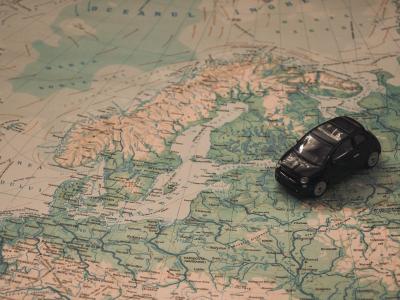
Abstract
In politics world, tourism is considered to be a key component of the 3rd Wellbeing Revolution, which can generate real improvement in quality of life. Also known as the “Dream Industry”, tourism offers its clients complex products characterized by tangible and intangible components, capable of meeting the most varied and unique motives identified or generated by demand creators.
The role of tourism in the national economy is particularly important, due to its complexity and the range of activities leading to its appearance, maintenance and development. From the hypothesis that the tourism industry represents a sector of activity with profound implications on the economic and social life and the quality it is essential to determine the concrete results of tourism. The measurement of these results is particularly important, given that many countries are turning to this sector to stimulate economic growth. In many countries, the size of tourism activity is still unclear as the results produced in the economy because there is no relevant statistical information.
Until recently, the tourist offer was calculated only as the number of beds in hotels, apartments, villas, etc., and tourism demand was considered as the expression of the number of overnight stays and arrivals for a destination/region/country. These indicators are useful, but do not indicate the entire tourist activity of a country. Therefore, efforts have been made over recent years to establish a system for collecting complex statistical data to indicate the magnitude of the effects of tourism.
The Tourism Information System (SIT) and the Satellite Tourism Account (TSA) are part of these tourist information collection systems. In this paper we will analyze how to collect tourism information for the year 2015.
Table of contents
1. Introduction
2. Methodology
3. Results and discussions
4. Conclusions
1. Introduction
The importance of concrete tourism results and the way they are measured are incontrovertible, as many countries resort to (even rely) on this sector to stimulate (and secure) economic growth. It is necessary to evaluate the economic results in terms of value added, labor force absorption, exports, imports etc., so the measurement becomes more and more complex.
In many countries, the size of tourism activity is still unclear as the results produced in the economy because there is no relevant statistical information. An efficient tourism policy that leads to sector development needs data on the structure of tourism demand and supply and its effects on the economy.
2. Methodology
Tourist activity is difficult to measure, whether it is local, regional, national or, above all, international tourism.
There are five types of tourism measurement systems with a wide practical applicability [1] and for different purposes: a general tourism information system (SIT), the Tourism Satellite Account (TSA), tourism studies, and vacancies, tourist production indicators, tourist barometer. There may be other systems applied by each country.
The paper analyzes the way of tracking tourist activity through the Tourism Satellite Accoun (TSA) in Romania in 2015.
3. Results and discussions
The Tourism Satellite Account (TSA) is different from a general information system. All elements included in the General Information System (SIT) can be found within the TSA, but it provides more data. Important environmental and marketing policy elements are not reflected in the SIT.
“A tourism satellite account is a set of definitions, integrated classifications, organized in a logical way that allow a picture of the economic impact of tourism in terms of supply and demand.” This account has been developed by the United Nations to measure the size of the economic sector that is not included in its own national accounts. In other words, it is a tourism information system integrated into the national account system. TSA appeared as a necessity because [2].
- governments often underestimate the economic benefits that tourism provides as it is not visible, like other industries.
- the business community often does not realize the role that tourism has in their success and does not benefit from all the advantages of its growth due to its limited measurement possibilities.
- the citizens do not take seriously the tourism potential.
Tourist activity generates significant amounts of personal spending, employment, value added, and government revenue. Only a small part of the money is spent by tourists on what is usually considered to be the tourism industry (hotels, restaurants etc.), most of which are outside the classical tourist industry such as museums, shops, public transport, etc.
According to Eurostat, the main goals of the TSA are to describe the structure of tourist activity in a country or region and to provide [3].
• Aggregated macroeconomic indicators to describe the economic size and importance of tourism, such as value added and GDP generated by tourism;
• detailed data on tourism consumption and how it is ensured from domestic production and imports;
• detailed production accounts in the tourism industry, employment data, connections with other productive activities and capital formation;
• The link between the economic data and the SIT items.
The basic structure of the TSA is given by the general balance existing in an economy between the demand for goods and services generated by tourism and the tourist offer. It analyzes in detail all aspects of demand for goods and services that can be associated with tourism activities in the economy in order to observe the operational interface with the supply of such goods in the economy and to describe how the tourist offer interacts with other activities [3].
To highlight this structure, it is necessary to address tourism demand and supply from the perspective of the Tourism Satellite Account.
According to the TSA concept, in terms of tourism demand, it is important to collect data on “visitor” (tourist and excursionist) and “tourism consumption”.
The latter term holds the central role in calculating tourist demand, being defined as: “Visitor purchases before, during and after the trip, these being related to the journey that takes place outside its usual environment.”
It should be noted that some shopping made before the trip (eg passports, small souvenirs to be offered a gift) and after (developing pictures etc.) are included as long as they are directly linked to the journey.
Aggregate indicators that include the types of tourism consumed (domestic, inbound, outbound, domestic or national) are linked to the visitor. There are four major components of demand: Visitor spending in cash; Visitor spending in nature, social transfers in nature, travel business expenses.
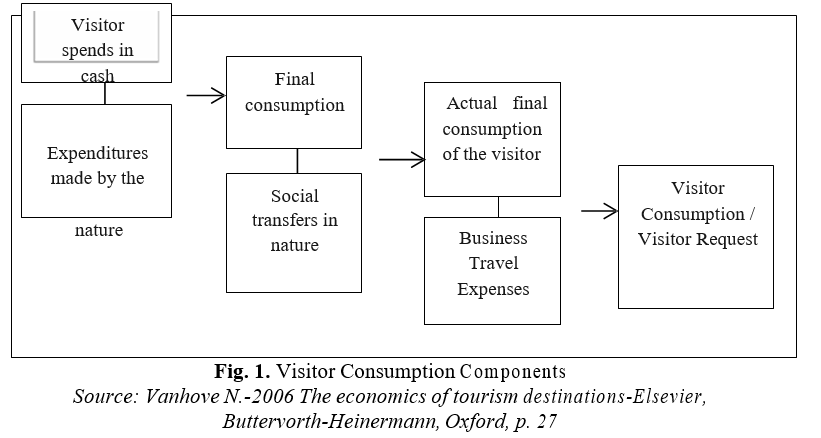
Cash spend refers to what constitutes “visitor’s expenses” and these are part of the final demand in terms of entry-exit, representing the most important component of final consumption. Goods purchased for travel by the visitor are classified as goods used exclusively during the stay at the destination (ski equipment, travel bag, tents, etc.) and goods with multiple purposes, which are used both during and after the journey (appliances photo, video, cars, etc.).
The former is always included in TSA statistics, while the second category will only be included in the TSA if the goods are purchased during the trip.
Expenditure in kind refers to non-financial transactions and includes barter operations (holiday home change), production for own use (the second self-built or non-taxed home) and in-kind income (holidays offered by employer).
Social tourism in nature refers to services provided by governmental or non-profit organizations serving households (medical services for visitors, visits to museums, the cost of which is not attributed to the visitor).
Museum entrance fees paid by visitors are included in the visitor’s cash consumption.
Tourism business spends are those considered to be business-mediated consumption, governmental and non-profit organizations (transportation and accommodation of employees in business trips).
There are also collective expenditures on tourism, those that relate to the provision of tourism legislation and regulations, the promotion of tourism through public travel agencies, the maintenance of public order and safety and the care of public spaces. These expenditures are not considered as belonging to tourism accounts, remaining within government consumption.
An important aspect is the gross fixed capital formation, which has a decisive role because it refers to the existence of infrastructure in terms of attractions, transport, accommodation, airports, public utilities and other elements that determine the nature and intensity of tourist flows. To this end, public and private investments are needed, and the extent to which they are needed and used by tourists is difficult to estimate.
The way in which these spending on visitors’ consumption is estimated is provided by the World Tourism and Travel Council (WTO) on the basis of existing data (national statistics), household surveys, visitor studies, daily studies, study at accommodation structures, studies conducted at border studies, studies on transport vehicles etc [4].
The economic analysis of tourism requires the identification of specific tourist products – the resources used by tourists on vacation, their consumption of goods and services and, as a result, the identification of economic units supplying goods and services [5].
The first stage involves the classification of goods and services, as they have a different relevance in the estimation of tourism consumption. The level and structure of a person’s consumption are different when they are at home and when they are out of their ordinary environment.
The National Accounts System (NAS) suggested a number of steps in identifying different product groups.
Establishing the characteristics of tourism goods and services is particularly important in this process – all products that in many countries could cease to exist in a significant quantity (or consumption that can be significantly reduced) in the absence of tourism and for which it would be statistical information (eg accommodation, transport services, cable transport, etc.) may be included in the category of specific goods and services [6].
The TSA distinguishes between 7 groups (each with subdivisions) of tourism-related products (services): accommodation, mass and drink services, passenger transport, travel agencies, tour operators and tourist, cultural, entertainment and recreation and various tourist services.
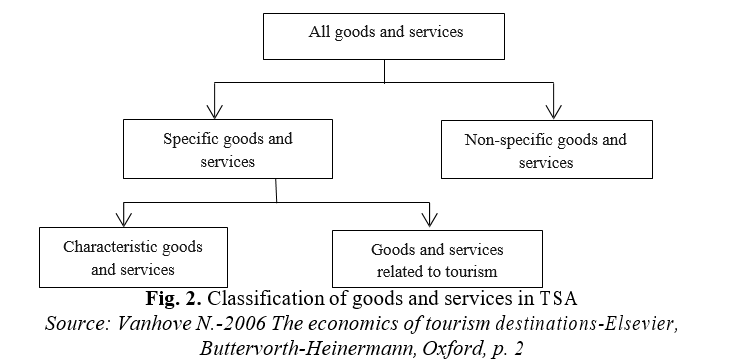
The second category (tourism related goods and services) reflects all those products that are consumed by tourists in volume, significant for visitors and/or suppliers, but not included in the list of tourism-specific products (eg exchange rate, cable transport etc.). Characteristic goods and services related to tourism make together „tourism specific products”.
Non specific goods and services or unusual tourism production include, for example, the bulk of consumer goods. In the category of tourism specific activities, the TSA includes 12 activities: hotels and associated, second private property, restaurants and associated facilities, various categories of transport services (by rail, road, sea, air, car rental), travel and subsistence agencies, cultural services, sports services and other recreational services [7].
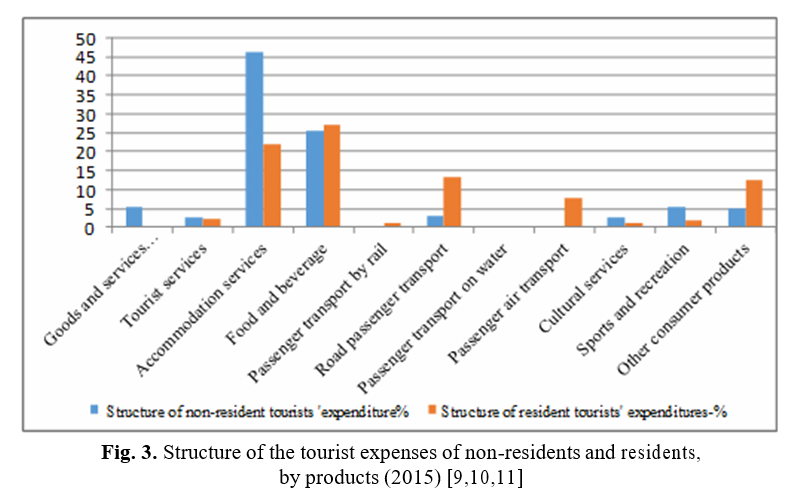
An important aspect of tourism-specific activities is direct contact between the consumer and the supplier of the products [8]. Some activities may be characteristic of tourism due to the importance of the resulting products for tourists, as many of them are not intended for tourists. This is the case with products from transport or restaurants (restaurant food is consumed to the same extent by visitors and non-visitors).
The statistical data contained in the TSA in 2015 highlight the following:
- the tourist expenses made in Romania by non-resident visitors amounted to 6133.9 million lei current prices. Of the total expenditures, the highest weights were registered by visitors’ accommodation services (46.4%), followed by food and beverage expenses (25.3%).
- the tourist expenses of the Romanian residents amounted to 31009.2 mil lei current prices.
The highest share of these expenditures was recorded for food and beverages (27.0%), followed by accommodation (22.0%).
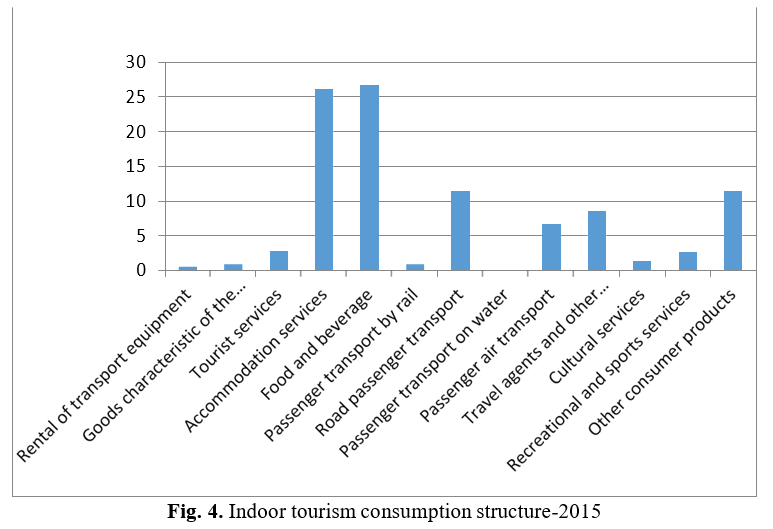
The analysis of expenditures made exclusively by the non-reference economy by residents traveling outside it indicated that in 2015 the Romanian tourists spent 4430.0 million lei, more for accommodation services (1260.5 million lei) and for food and beverage service (i 754.3 million lei) [12,13].
The consumption of indoor tourism for the year 2015 was 37481,3 mil lei, with higher weights for food and drink (26.7%), followed by expenditures for accommodation services (26.2%).
The confrontation between domestic supply and domestic consumption determines information that helps us calculate in TSA three main indicators - gross added value in the tourism industry, direct gross value added from tourism and gross domestic product directly from tourism.
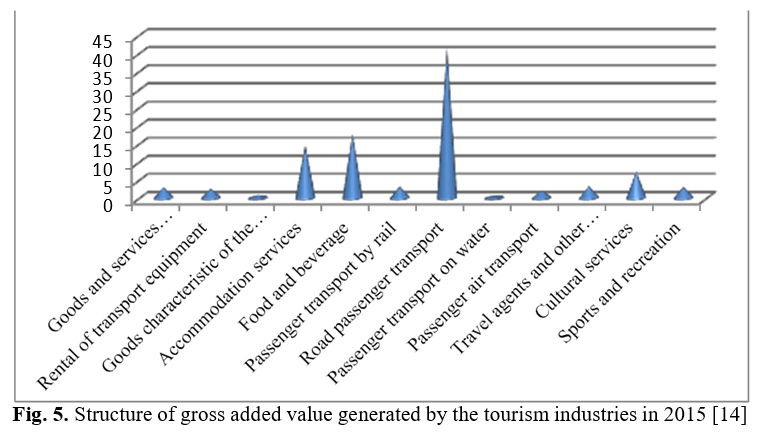
Gross value added in the tourism industry in 2015 amounted to 33426.3,1 mil lei, with high weights for passenger transport by road and food and drink, very low water transport (202.5 mil lei). The share of gross value added in the tourism industry in total value added in Romania was 2.1% [15].
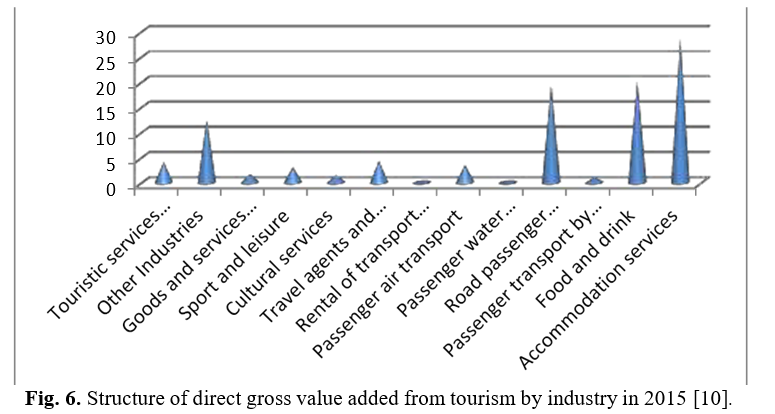
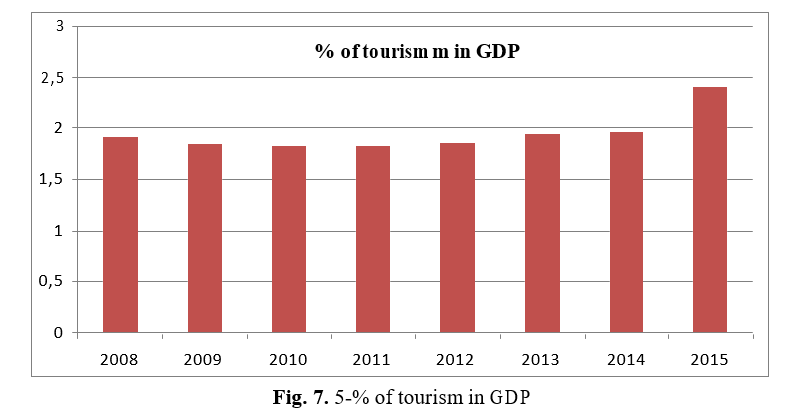
Direct gross value added from tourism amounted to 216274 million lei. Large accommodation services were provided, followed by meals and drinks. Direct GDP from tourism was 17037.3 million lei, or 2.39% of total GDP (712658.5 million lei).
4. Conclusions
The tourism plays an important role in the economic and social life of the world’s states, determining the interest in identifying and evaluating its results.
At the level of a country or region's economy, the effects of tourism should generally be considered from their relationship with the fundamental objectives of the entire economic system; the contribution of tourism to economic growth, price stability, balance of payments, equitable distribution of national income and full use of labor can be determined. Tourism is:
- a very complex economic, social and cultural phenomenon
- there is a relationship of interconditionality between tourism and other (multiple) economic activities
- measuring its economic contribution to places visited and various interdependencies is absolutely necessary and difficult.
Contributo selezionato da Filodiritto tra quelli pubblicati nei Proceedings “International Conference on Life Sciences - 2018”
Per acquistare i Proceedings clicca qui:
https://www.filodiritto.com/proceedings
Contribution selected by Filodiritto among those published in the Proceedings “International Conference on Life Sciences - 2018”
To buy the Proceedings click here:



